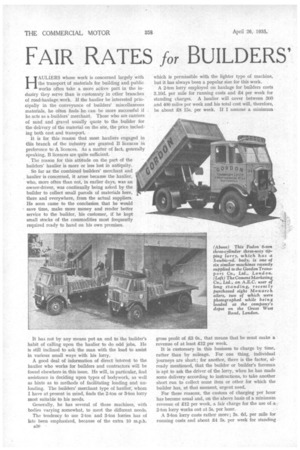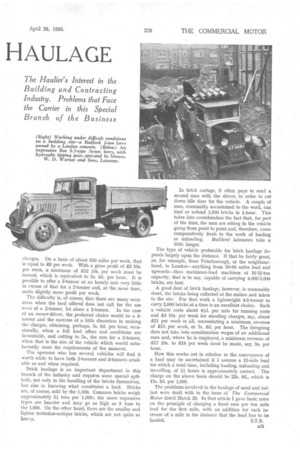FAIR RATES for BUILDERS'
Page 48

Page 49

If you've noticed an error in this article please click here to report it so we can fix it.
HAULAGE
The Haulier's Interest in the Building and Contracting Industry. Problems that Face the Carrier in this Special Branch of the Business
HAULIERS whose work is concerned largely with the transport of materials for building and public works often take a more active part in the industry they serve than is customary in other branches of road-haulage. work. If the haulier be interested principally in the conveyance of builders' miscellaneous materials, he often finds he can be more successful if he acts as a builders' merchant. Those who are carriers of sand and gravel usually quote to the builder for the delivery of the material on the site, the price including both cost and transport.
It is for this reason that most hauliers engaged in this branch of the industry are granted B licences . in preference to A licences. As a matter of fact, generally speaking, B licences are quite sufficient.
. The reason for this attitude on the part of the builders' haulier is more or less lost in antiquity. So far as the combined builders' merchant and . haulier is concerned, it arose because the haulier, who, more often than not, in earlier days, was-an owner-driver, was continually being asked by the builder to collect small parcels of materials here, there and everywhere, from the actual suppliers. He soon came to the conclusion that he would save time, make more money and render better service to the builder, his customer, if he kept small stocks of the commodities most frequently required ready to hand on his own premises.
It has not by any means put an end to the builder's habit of calling upon the haulier to do odd jobs. He is still inclined to ask the man with the load to assist in various small ways with his lorry.
A good deal of information of direct interest to the haulier who works for builders and contractors will be found elsewhere in this issue. He will, in particular, find assistance in deciding upon types of bodywork, as well as hints as to methods of facilitating loading and unloading. The builders' merchant type of haulier, whom I have at present in mind, finds the 2-ton or 3-ton lorry most suitable to his needs.
Generally, he has several of these machines, with bodies varying somewhat, to meet the different needs. The tendency to use 2-ton and 3-ton lorries has of late been emphasized, because of the extra 10 m.p.h. B30 which is permissible with the lighter type of machine, but it has always been a popular size for this work.
A 2-ton lorry employed on haulage for builders costs 3.10d. per mile for running costs and 24 per week for standing charges. A haulier will cover between 300 and 400 miles per week and his total cost will, therefore, be about 28 15s. per week. H I assume a minimum
gross profit of 23 Os., that means that he must make a revenue of at least 212 per week.
It is customary in this business to charge by time, rather than by mileage. For one thing, individual journeys are short ; for another, there is the factor, already mentioned, that the builder or builder's foreman is apt to ask the driver of the lorry, when he has made some delivery according to instructions, to take another short run to collect some item or other for which the builder has, at that moment, urgent need.
For these reasons, the custom of charging per hour has become usual and, on the above basis of a minimum revenue of 212 per week, a fair charge for the use of a 2-ton lorry works out at 5s. per hour.
A 3-ton lorry costs rather more ; 3s. 6d. per mile for running costs and about 24 5s. per week for standing charges. On a basis of about 350 miles per week, that is equal to 49 per week. With a gross profit of 43 10s. per week, a minimum of 412 10s. per week must be earned, which is equivalent to 5s. 3d. per hour. It is possible to offer a 3-tonner at an hourly rate very little in excess of that for a 2-tonner and, at the same time, make slightly more profit per week.
The difficulty is, of course, that there are many occasions when the load offered does not call for the use even of a 2-tonner, let alone a 3-banner. In the case of an owner-driver, the preferred choice would be a 3tanner and the exercise of a little discretion in making the charges, obtaining, perhaps, 5s. 6d. per hour, occasionally, when a full load offers and conditions are favourable, and cutting to 5s., the rate for a 2-tonner, when that is the size of the vehicle which would satisfactorily meet the requirements of the moment.
The operator Who has several vehicles will find it worth while to have both 2-tonners and 3-tonners available as and when required.
Brick haulage is an important department in this branch of the industry and requires some special aptitude, not only in the handling of the bricks themselves, but also in knowing what constitutes a load. Bricks are, of course, sold by the 1,000. Common bricks weigh approximately 21 tons per 1,000; the more expensive types are heavier and may go as high as 3 tons to the 1,000. On the other hand, there are the smaller and lighter imitation-antique bricks, which are not quite so heavy. In brick cartage, if often pays to send a second man with the driver, in order to cut down idle time for the vehicle. A couple of men, reasonably accustomed to the work, can load or unload 1,000 bricks in 1-hour. This takes into consideration the fact that, for part of the time, the men are sitting in the vehicle going from point to point and, therefore, come comparatively fresh to the work of loading or unloading. Builders' labourers take a little longer.
The type of vehicle preferable for brick haulage depends largely upon the distance. If that be fairly great, as, for example, from Peterborough, or the neighbourhood, to London—anything from 50-60 miles lead and upwards—then maximum-load machines of 10-12-ton capacity, that is to say, capable of carrying 4,000-5,000 bricks, are best.
A good deal of brick haulage, however, is reasonably short, the bricks being collected at the station and taken to the site. For that work a lightweight 4-5-tonner to carry 2,000 bricks at a time is an excellent choice. Such a vehicle costs about 41d. per mile for running costs and 44 10s. per week for standing charges, say, about 411 per week in all, necessitating a minimum revenue of 415 per week, or 7s. 6d. per hour. The foregoing does not take into consideration wages of an additional man and, where he is employed, a minimum revenue of 417 10s. to 418 per week must be made, say, 9s, per hour.
How this works out in relation to the conveyance of a load may be ascertained if I assume a 15-mile lead for which a total time, including loading, unloading and travelling, of 21 hours is approximately correct. The charge on the above basis should be 22s. 6d., which is 11s. 3d. per 1,000.
The problems involved in the haulage of sand and ballast were dealt with in the issue of The Commercial Motor dated March 29. In that article I gave basic rates on the principle of charging a fixed sum per ton mile lead for the first mile, with an addition for each increase of a mile in the distance that the load has to be
hauled. S.T.R.




































































































